
Chaeteessidae is a family of praying mantises. It contains a single extant genus, Chaeteessa, native to South America which is thought to be the most primitive and earliest diverging lineage of living mantises. Fossil genera are known from the Paleogene of Eurasia and North America.

Eosimias is a genus of early primates, first discovered and identified in 1999 from fossils collected in the Shanghuang fissure-fillings of Liyang, the southern city of Jiangsu Province, China. It is a part of the family Eosimiidae, and includes three known species: Eosimias sinensis, Eosimias centennicus, and Eosimias dawsonae. It provides us with a glimpse of a primate skeleton similar to that of the common ancestor of the Haplorhini. The name Eosimias is designed to mean "dawn monkey", from Greek eos "dawn" and Latin simius "monkey".

Phenacodus is an extinct genus of mammals from the late Paleocene through middle Eocene, about 55 million years ago. It is one of the earliest and most primitive of the ungulates, typifying the family Phenacodontidae and the order Perissodactyla.
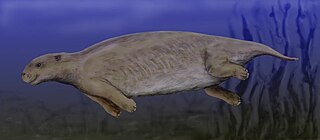
Prorastomus sirenoides is an extinct species of primitive sirenian that lived during the Eocene Epoch 40 million years ago in Jamaica.
Archaeospheniscus is an extinct genus of large penguins. It currently contains three species, known from somewhat fragmentary remains. A. wimani, the smallest species, was found in Middle or Late Eocene strata of the La Meseta Formation on Seymour Island, Antarctica, whereas the other two, about the size of a modern emperor penguin, are known from bones recovered from the Late Oligocene Kokoamu Greensand Formation at Duntroon, New Zealand.

Ailuravus is a genus of prehistoric rodents in the family Ischyromyidae.
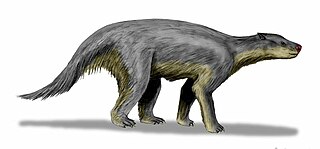
Pantodonta is an extinct suborder of eutherian mammals. These herbivorous mammals were one of the first groups of large mammals to evolve after the end of the Cretaceous. The last pantodonts died out at the end of the Eocene.
Limenavis is a genus of ornithuran dinosaurs from the Late Cretaceous. It lived about 70 million years ago, around the Campanian-Maastrichtian boundary. Known from several broken bones, the remains of the only known species Limenavis patagonica were found in rocks of the "lower member" of the Allen Formation at Salitral Moreno, 20 km south of General Roca, Río Negro (Argentina). It is one of the closest relatives, in the fossil record, of the modern birds.

The Fur Formation is a marine geological formation of Ypresian age which crops out in the Limfjord region of northern Denmark from Silstrup via Mors and Fur to Ertebølle, and can be seen in many cliffs and quarries in the area. The Diatomite Cliffs is on the Danish list of tentative candidates for World Heritage and may become a World Heritage site. Fossils found in the Fur Formation are primarily housed at the Fossil and Mo-clay Museum on Mors Island, the Fur Museum on Fur Island, and the Natural History Museum of Denmark in Copenhagen.
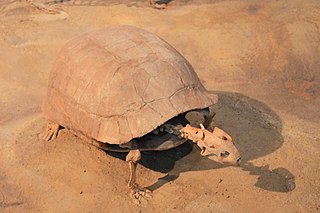
Stylemys is the first fossil genus of dry land tortoise belonging to the order Testudines discovered in the United States. The genus lived in temperate to subtropical areas of North America, Europe, and Asia, based on fossil distribution. The genus was first described in 1851 by Joseph Leidy. The tortoise was common in the prehistoric Badlands, especially Nebraska and South Dakota. The species has also been found in the formations in and around Badlands National Park. Fossil fragments have also been found in the Palm Park Formation of New Mexico.
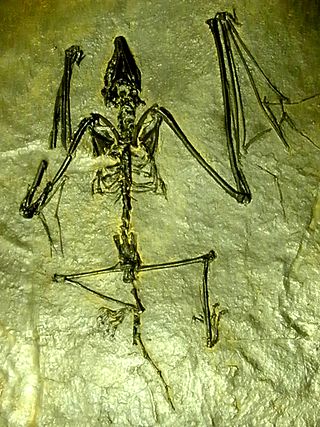
Archaeonycteris is an archaic bat genus whose fossilised remains have been found in Germany, France, England and India.

Cylindracanthus is an extinct, enigmatic genus of marine ray-finned fish with fossils known throughout North America, Europe, Asia and Africa from the Late Cretaceous to the late Eocene, with potential Oligocene records and a possible Miocene record also known. It is exclusively known from its distinctive partial remains, which are long cylindrical bony spines that are usually considered rostrum fragments, as well as some associated teeth. These spines are abundant & widespread throughout this timespan, and are useful indicators of a nearshore marine environment, but the taxonomic identity of the fish is still highly uncertain and debated.
Eostrix is a genus of extinct primitive owls in the family Protostrigidae, along with Oligostrix and Minerva. These owls date from the early Eocene of the United States, Europe, and Mongolia. They have been described based on fossil remains. The genus was created by Pierce Brodkorb in 1971 to place a fossil species known until that time as Protostrix mimica.

Ithonidae, commonly called moth lacewings and giant lacewings, is a small family of winged insects of the insect order Neuroptera. The family contains a total of ten living genera, and over a dozen extinct genera described from fossils. The modern Ithonids have a notably disjunct distribution, while the extinct genera had a more global range. The family is considered one of the most primitive living neuropteran families. The family has been expanded twice, first to include the genus Rapisma, formerly placed in the monotypic family Rapismatidae, and then in 2010 to include the genera that had been placed into the family Polystoechotidae. Both Rapismatidae and Polystoechotidae have been shown to nest into Ithonidae sensu lato. The larvae of ithonids are grub-like, subterranean and likely phytophagous.

Micropterigoidea is the superfamily of "mandibulate archaic moths", all placed in the single family Micropterigidae, containing currently about twenty living genera. They are considered the most primitive extant lineage of lepidoptera, and the sole superfamily in the suborder Zeugloptera. The name comes from the Greek for mikros, little and pterux, a wing. Unique among the Lepidoptera, these moths have chewing mouthparts rather than a proboscis, and are seen feeding, often in large aggregations, on the pollen of the flowers of many herbaceous plants, shrubs and trees. The fossil record of the group goes back to the middle-late Jurassic with the earliest known species being Auliepterix from the Karabastau Formation in Kazakhstan.
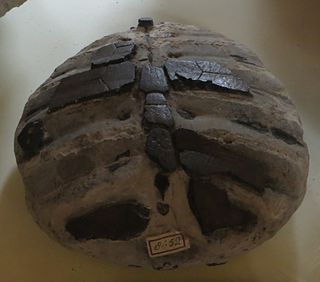
Puppigerus is an extinct genus of sea turtle from the Eocene. It is known from finds in the United States, the United Kingdom, Belgium, Denmark, and Uzbekistan.
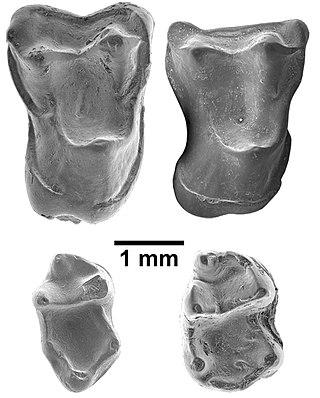
Afrasia djijidae is a fossil primate that lived in Myanmar approximately 37 million years ago, during the late middle Eocene. The only species in the genus Afrasia, it was a small primate, estimated to weigh around 100 grams (3.5 oz). Despite the significant geographic distance between them, Afrasia is thought to be closely related to Afrotarsius, an enigmatic fossil found in Libya and Egypt that dates to 38–39 million years ago. If this relationship is correct, it suggests that early simians dispersed from Asia to Africa during the middle Eocene and would add further support to the hypothesis that the first simians evolved in Asia, not Africa. Neither Afrasia nor Afrotarsius, which together form the family Afrotarsiidae, is considered ancestral to living simians, but they are part of a side branch or stem group known as eosimiiforms. Because they did not give rise to the stem simians that are known from the same deposits in Africa, early Asian simians are thought to have dispersed from Asia to Africa more than once prior to the late middle Eocene. Such dispersals from Asia to Africa also were seen around the same time in other mammalian groups, including hystricognathous rodents and anthracotheres.

Glyptosaurinae is an extinct subfamily of anguid lizards that lived in the Northern Hemisphere during the Late Cretaceous and the Paleogene.
Propliopithecoidea is a superfamily of catarrhine primates that inhabited Africa and the Arabian Peninsula during the Early Oligocene about 32 to 29 million years ago. Fossils have been found in Egypt, Oman and Angola. They are one of the earliest known families of catarrhines. They have a number of features in common with extant catarrhines, but also features that are primitive and not found in later catarrhine families.
The Silveirinha Formation is an Early Eocene geologic formation of the Mondego Basin in the Região Centro of central-western Portugal. The sandstones, siltstones and conglomerates were deposited in an alluvial environment.














